Portals and Paintings
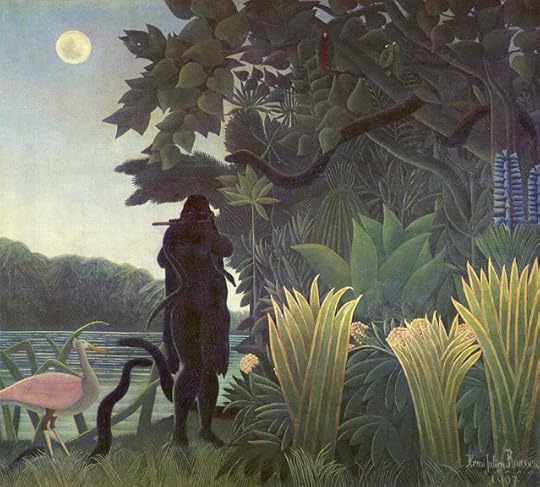
A very long time ago inmy late teens, I wrote a book with the rather unimaginative title ‘The MagicForest’ which was (quite rightly) never published. Although derivative (I was inspiredby Walter de la Mare’s strange and wonderful novel ‘The Three Royal Monkeys’)it was nevertheless the closest I’d yet got to finding my own voice; and I’dbeen writing lengthy narratives ever since nine or ten years old. It was adream-quest story in which a girl goes through a picture into a magical world:the picture in question was a reproduction of Henri Rousseau’s ‘The Snake-Charmer’ which hung on my bedroom wall (see above). Myheroine, Kay, looks at it and sees
...the ripples of a lake reflecting the quick luminousafterglow of a sun’s sinking. There were night-flowering reeds and a tall,heron-like bird, and standing in the darkness of the trees, partly insilhouette against the night sky, was a human figure. It was wearing a darkcloak and piping on a flute. Answering the flute came snakes, great forest pythonspouring scarcely distinguishable from the branches and from the lake. Kay’s feetsank into shallow mud. She heard the low, hollow-sweet notes, saw the snakestwist about the charmer’s legs. A heavy, scaly body dragged over her foot.Midges stung and bit her, but a little coolness came breathing over the water.
And so begins an adventure which I won’t bore you with, it's enough to say that Kay goes on aquest with a yellow water-bird and a monkey, to find a sorcerer who has infestedthe forest with poisonous butterflies.
I knew that ‘going into a picture’ was not an original ideabut one which had appeared in several of my favourite children’s books. In C.S.Lewis’s ‘The Voyage of the Dawn Treader’ (1952) Lucy and Edmond Pevensie, andtheir cousin Eustace Scrubb, tumble into a painting of what looks like aNarnian ship at sea. When Eustace asks Lucy why she likes it, she replies, ‘because the ship looks as if it was really moving. And the water looks as ifit was really wet. And the waves look as if they were really going up and down.’She’s right, they are doing thesethings. The ship rises and falls over the waves, a wind blows into the roombringing a ‘wild, briny smell’, and ‘Ow!’ they all cry, for ‘a great, cold,salt splash had broken right out of the frame and they were breathless from thesmack of it, besides being wet through.’ As Eustace rushes to smash the paintingthe other two try to pull him back. Next moment all three are struggling on theedge of the picture frame, and a wave sweeps them into the sea.

Lewis didn’t invent the ‘picture as portal’ trope, either.It’s quite likely he found it in a Japanese tale, ‘The Story of Kwashin Koji’ from‘Yasō-Kidan’ (‘Night-Window Demon Talk’), a book of legends collected byIshikawa Kosai (1833-1918) and retold by Lafcadio Hearn in his 1901 book ‘AJapanese Miscellany’. It is the sort of thing Lewis would have read. It tellsof Kwashin Koji, a rather disreputable old fellow and a heavy drinker, who madea living ‘by exhibiting Buddhist pictures and by preaching Buddhist doctrine.’On fine days he would hang a large picture – ‘a kakemono on which were depictedthe punishments of the various hells’ – on a tree in the temple gardens andpreach about it. The painting was so wonderfully vivid that onlookers wereamazed.
Hearingthis, the ruler of Kyōto, Lord Nobunaga, commanded Kwashin Koji to bring it tothe palace where he could view it. The old man obliged and Nobunaga was deeply impressedby the painting. Noticing this, his servant suggested that Kwashin should offerit as a gift to the great lord. Since his livelihood depended upon the picture,Kwashin asked instead for payment in gold, which was refused. So he rolled up thepicture and left. But the servant followed him, killed him, and took the picturefor his lord. When the scroll was unrolled, however, it was found to be completelyblank – while Kwashin had mysteriously returned to life and was showing hispicture in the temple grounds as before. Some time later Nobunaga was himself murderedby Mitsuhidé, one of his captains, who invited Kwashin Koji to the palace, feastedhim and gave him plenty to drink. The old man then pointed to a large foldingscreen which depicted ‘Eight Beautiful Views of the Lake of Omi’, and said, ‘Inreturn for your august kindness, I shall display a little of my art’. Far off inthe background, the artist had painted a man rowing a boat, ‘occupying, uponthe surface of the screen, a space of less than an inch in length.’ As KwashinKoji waved his hand, everyone in the room saw the boat turn and begin to approachthem. It grew rapidly larger...
And all of a sudden, the water of the lake seemed tooverflow out of the picture into the room, and the room was flooded; and thespectators girded up their robes in haste as the water rose above their knees.In the same moment the boat appeared to glide out of the screen, and thecreaking of the single oar could be heard. Then the boat came close up toKwashin Koji, and Kwashin Koji climbed into it; and the boatman turned about, andbegan to row away very swiftly. And as the boat receded, the water in the roombegan to lower rapidly, seeming to ebb back into the screen... But still thepainted vessel appeared to glide over the painted water, retreating furtherinto the distance and ever growing smaller, till ... it disappeared altogether,and Kwashin Koji disappeared with it. He was never again seen in Japan.
The lakewater floodingout of the painted screen corresponds to the ‘great salt splash’ of the wave burstinginto the children’s bedroom in ‘The Voyage of the Dawn Treader’, while thecreaking oar finds an echo in Lewis’s description of ‘the swishing of waves andthe slap of water against the ship’s sides and the creaking and the overallhigh steady roar of air and water’.
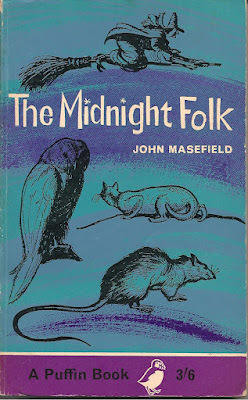
John Masefield’s ‘The Midnight Folk’ (1927), and its sequel‘The Box of Delights’ (1935) contain some delightful ‘pictures as portals’. In‘The Midnight Folk’ little Kay Harker, left by his governess to learn the verb‘pouvoir’, looks up as the portrait of his great-grandpapa comes to life:
As Kay looked, great-grandpapa Harker distinctly took astep forward, and as he did so, the wind ruffled the skirt of his coat andshook the shrubs behind him. A couple of blue butterflies which had been uponthe shrubs for seventy odd years, flew out into the room. ... Great-grandpapaHarker held out his hand and smiled... “Well, great-grandson Kay,” he said, “nepouvez vous pas come into the jardin avec moi?” [....]
Kay jumped on to the table; from there,with a step of run, he leaped on to the top of the fender and caught themantelpiece. Great-grandpapa Harker caught him and helped him up into thepicture. Instantly the schoolroom disappeared. Kay was out of doors standingbeside his great-grandfather, looking at the house as it was in the pencildrawing in the study, with cows in the field close to the house on what was nowthe lawn, the church, unchanged, beyond, and, near by some standard yellowroses, long since vanished, but now seemingly in full bloom.
His great-grandfathertakes him into the house, where ‘A black cat, with white throat and paws, whichhad been ashes for forty years, rubbed up against great-grandpapa’s legs andthen, springing on the arm of his chair, watched the long-dead sparrows in theplum tree which had been firewood a quarter of a century ago’. This beautifullygentle transition into the past aswell as into a painting is something I’ve always loved: it depicts time past withyearning but without melancholy, and we see little orphaned Kay receive careand support from kind ancestors who watch over him. Exciting as it is, ‘TheMidnight Folk’ is a book a child can read and never feel unsafe. Later in the story,Kay realises that his governess is really a witch, and his grandmother’sportrait addresses him.
“Don’t let a witch take charge at Seekings. This is a housewhere upright people have lived. Bell her, Kay; Book her, boy; Candle her,grandson; and lose no time: for time lost’s done with, but must be paid for.”
He looked upat her portrait, which was that of a very shrewd old lady in a black silkdress. She was nodding her head at him so that her ringlets and earrings shook.“Search the wicked creature’s room,” she said, “and if she is, send word to the Bishop at once.”
“All right,”Kay said, “I’ll go. I will search.”
This time Kay doesn’tenter the picture, but his grandmother’s words give him strength, confidenceand purpose.
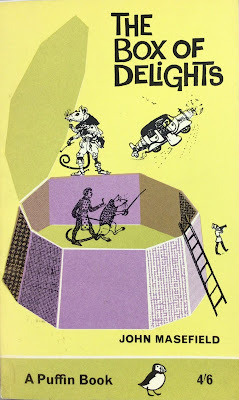
Astring of pack mules descend the mountain path, and near the end of the line trotsa white mule with a red saddle.
The first mules turned off at a corner. When it came to theturn of the white mule to turn, he baulked, tossed his head, swung out of theline, and trotted into the room, so that Kay had to move out of the way. Therethe mule stood in the study, twitching his ears, tail and skin against thegadflies and putting down his head so that he might scratch it with his hindfoot. “Steady there,” the old man whispered to him. “And to you, Master Kay, Ithank you. I wish you a most happy Christmas.”
At that, he swung himself onto the mule,picked up his theatre with one hand, gathered the reins with the other, said,“Come, Toby,” and at once rode off with Toby trotting under the mule, out ofthe room, up the mountain path, up, up, up, till the path was nothing more thana line in the faded painting, that was so dark upon the wall.
One of the many reasonsthis passage works so well is its detailed physicality, the realistic animalbehaviour of the mule quivering its skin and scratching its head and taking upso much room in the study. And as magic, it’s such a satisfactory way to foil the baddies.
Towardsthe end of the book, Kay has ‘gone small’ via the magic of the Box of Delightsbut having temporarily lost the Box he cannot restore himself to his propersize. Finding Cole Hawlings chained and caged in the underground caverns whichAbner Brown is about to flood, he creeps into Cole’s pocket for a bit of leadpencil and a scrap of paper on which to draw, at Cole’s request, ‘two horsescoming to bite these chains in two’. Though plagued by the snapping jaws oflittle magical motor-cars and aeroplanes, he manages to draw the horses ratherwell.
The drawings did stand out from the paper rather strangely.The light was concentrated on them; as he looked at them the horses seemed tobe coming towards him out of the light; and no, it was not seeming, they weremoving; he saw the hoof casts flying and heard the rhythmical beat of hoofs. Thehorses wer coming out of the picture, galloping fast, and becoming brighter andbrighter. Then he saw that the light was partly fire from their eyes and manes,partly sparks from their hoofs. “They are real horses,” he cried. “Look.”
It was asthough he had been watching the finish of a race with two horses neck and neckcoming straight at him... They were two terrible white horses with flamingmouths. He saw them strike great jags of rock from the floor and cast them,flaming, from their hoofs. Then, in an instant, there they were, one on eachside of Cole Hawlings, champing the chains as though they were grass, crushingthe shackles, biting through the manacles and plucking the iron bars as thoughthey were shoots from a plant.
“Steady there, boys,” said Cole...
Cole places thediminutive Kay on one of the horses and leads them along the rocky corridor,but the water is coming in fast. ‘Draw me,’ says Cole, ‘a long roomy boat witha man in her, sculling her’ and ‘put a man in the boat’s bows and draw him witha bunch of keys in his hand.’ Kay does his best, although the man’s nose is ‘ratherlike a stick’, and Cole places the drawing on the water. It drifts away whilethe stream becomes angrier and more powerful.
“The sluice-mouth has given way,” Kay said.
“That isso,” Cole Hawlings answered. “But the boat is coming too, you see.”
Indeed, downthe stream in the darkness of the corridor, a boat was coming. She had a lightin her bows; somebody far aft in her was heaving at a scull which ground in therowlocks. Kay could see and hear the water slapping and chopping against heradvance; the paint of her bows glistened above the water. A man stood above thelantern. He had something gleaming in his hand: it looked like a bunch of keys.As he drew nearer, Kay saw that this man was a very queer-looking fellow with anose like a piece of bent stick.
With its boatman, boat,creaking oar and rush of oncoming water, this too is very reminiscent of thetale of Kwashin Koji, which I suspect Masefield as well as Lewis may have read.Whether it’s so or not, both the concept and the writing are wonderful.
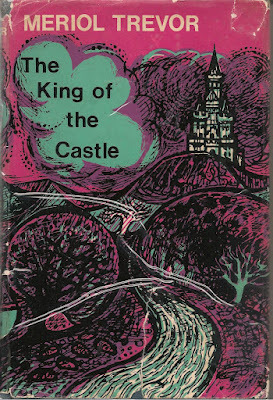
A novelwhich owes nothing to the Japanese story is Meriol Trevor’s ‘The King of theCastle’ (1966). A decade on from C. S. Lewis but largely forgotten today,Trevor’s books for children were well-written and sometimes powerful fantasieswith allegorical Christian themes; I would borrow them from the local library and enjoyed them.. They were less popular among children thanLewis’s books, probably because Trevor’s ‘Christ’ figures were human adults, whereLewis had a glorious golden lion. They follow in general the pattern of‘contemporary children find a way into magical worlds and go on quests’; herbest book is (I think) ‘The Midsummer Maze’, but ‘The King of the Castle’ is good too. It openswith a boy, Thomas, sick in bed (see mysteriousillnesses that keep children marooned in bed for weeks). Slowly recovering fromwhatever it was, he grows bored, so one day his mother gives him a gilt-framed pictureshe bought in a junk shop, so that he will ‘have something to look at insteadof the wallpaper’. This feels a bit forced; would a young boy really appreciate‘an old engraving in the romantic style’? But perhaps the castle swings it:
It showed a wild rocky landscape with twisted thorn treeson the horizon, bent by years of gales, and a few sheep prowling on the thingrass near a torrent which rushed turbulently out of a deep and shadowy ravine.Beside the river a road ran, white in the darkness, till it too disappearedbehind the steep shoulder of the gorge. Perhaps it led on to the castle whichbacked against a wild and stormy sky of clouds that rolled like smoke over thesombre hills.
Thomas thinks it ‘verymysterious’ and once it’s on the wall he lies looking at it.
He wondered where the road went after it turned the corner.He imagined himself walking along the road, rutted and dusty, stony as it was.The huge cliffs loomed above him.
“But I amwalking along the road,” Thomas thought suddenly. He looked down and saw hisfeet walking. They wore brown leather rubber-soled shoes. He was not wearingpyjamas but jeans and his thick sweater, but the wind seemed to cut through thewool. It was cold.
Following the road upbeside the rushing river, he turns to look back, wondering if he will see hisbedroom with himself lying in bed. But ‘what he saw was the wild country of thepicture extended backwards, the river running away and away towardsthick-forested hills. It was almost more unnerving to find himself totally inthe world of the picture.’ I like this acknowledgment of the unsettling side of suddenly entering an unknown world. Soon after, a young shepherd and his dog rescue Thomas from a wolf. The shepherd turns out to be this book’s Christ figure,and at the end of the story Thomas returns through the picture to find himselfback in bed.
Comparedwith with the other ‘paintings as portals’ discussed here, this is perhaps theweakest, since Thomas’s interaction with the engraving is entirely passive. It’s given to him and he doesn’t even need to leave his bed: just looking at it does the job. Characters in the other stories all have some degreeof agency in passing through the portals. Kwashin Koji is in full control of what happens: he can enter a painting at will. Lucy and Edmund topple into the Eastern Sea while actively trying to prevent Eustace breaking thepicture. Accepting his great-grandfather’s invitation, Kay Harkerclambers on to the mantelpiece to reach him. Like Kwashin Koji, Cole Hawlings chooses a painting to enter and escape through, while the rather older Kay Harker of ‘The Box of Delights’ draws the pictureswhich come to life and rescue them. (Do these drawings count as portals? Whileit’s true that Kay and Cole don’t pass through them, the horses, boats and boatmen emerge from the paper into this world, so I think they do.)

Kay’sdrawings of horses and boatmen bring me to the drawings in Catherine Storr’swonderfully sinister ‘Marianne Dreams’ (1958). Marianne is another child struckdown by an unnamed illness that keeps her in bed. Weeks on, bored and convalescent,she finds a stub of pencil in an old work-box and uses it to draw a house withfour windows, a door and a smoking chimney – to which she adds a fence, a gateand a path, a few flowers, ‘long scribbly grass’ and some rocks. Then she fallsasleep and dreams she’s alone in a vast grassland dotted with rocks. Walking towardsa faint line of smoke she arrives at a blank-eyed house with ‘a bare frontdoor’ ringed with an uneven fence and pale flowers. A cold wind springs up andshe’s frightened. ‘I’ve got to get away from the grass and the stones and thewind. I’ve got to get inside.’
Marianne’sdreams take her into the inimical ‘world’ of her drawing: what she finds theredepends on whatever she has recently drawn, plus the mood in which she drew it. The experience is uneasy from the start and becomes scarier at every visit. It’sarguable that the drawings (to which she keeps adding) are not portals at all, onlythe catalyst for dreams which express Marianne’s anger, fear and stress. Neverthelessthe strange ‘country’ in which she finds herself – and to a certain extent manipulates– feels psychologically serious and real; portals may work in more than oneway. She draws a boy looking out of the window, someone who can let her intothe house. Next night he is there. She discovers that his name is Mark: he isreal, very ill and unable to walk, and shares with her the same nice hometutor. In the dream world he is dependent on her: as the wielder of the pencilshe can draw things for his comfort – or not. In a fit of temper one day she scribblesthick black lines, like bars, all over the window where he sits – raises thefence, adds more stones in a ring around the house and gives to each one asingle eye. All these horrifying things become real in her next dream.
Marianne looked round the side of the window. From whereshe stood she could see five – six – seven of the great stones standingimmovable outside. As she looked there was a movement in all of them. The greateyelids dropped; there was a moment when each figure was nothing but a hunk ofstone, motionless and harmless. Then, together, the pale eyelids lifted andseven great eyeballs swivelled in their stone sockets and fixed themselves onthe house.
Mariannescreamed. She felt she was screaming with the full power of her lungs,screaming like a siren: but no sound came out at all. She wanted to warn Mark,but she could not utter a word. In her struggle she woke.
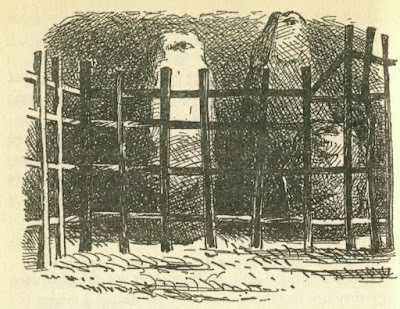
As the terrifying stoneWatchers crowd ever closer to the house, Marianne and Mark must escape.Marianne draws hills in the distance behind the house, with a lighthousestanding on them, for she knows the sea there, just out of sight. Eventuallythe children make it to the lighthouse on bicycles she has drawn. Here they aresafe, but Mark points out that they can’t stay forever. They must reach thesea, inaccessible below high cliffs. A helicopter is needed, but Mariannecannot draw helicopters. After struggling with herself to relinquish power (‘it’smy pencil!’) she draws the pencilinto the dream so that Mark can have it. He draws a helicopter which arrivesbefore Marianne can dream again, but leaves a message promising to make it comeback for her: in the end trust prevails.
Everything seemed to be resting; content; waiting. Markwould come: he would take her to the sea. Marianne lay down on the short,sweet-smelling turf. She would wait, too.
‘Marianne Dreams’ canbe genuinely frightening, nightmarish even; but the children’s bickering yetsupportive friendship enlivens the story and makes it accessible to youngreaders.

Lastly, I cannot resist mentioning James Mayhew’s much-lovedand utterly charming series of picture-books which introduce younger childrento art. ‘Katie’s Picture Show’ was the first, published in 2004 and followed byseveral others in which little Katie jumps into various famous paintings, meetsthe characters and has age-appropriate adventures.
Pictures,especially representative pictures, are like windows. We simultaneously look at them and through them. John Constable’s ‘The Cornfield’ lures the viewer in,past the young boy drinking from the brook, past the panting sheepdog and thedonkeys under the bushes, past the reapers busy in the yellow corn, and ontowards the far horizon. In imagination we enter not only the picture but also thelong-departed past of 1820s Suffolk – in much the same way as little Kay Harkerclambers into his great grandfather’s portrait and sees his home as it used tobe, generations before.

Who knowswhen the first person looked at a picture and imagined being inside it? Wecannot know, but it’s a natural thought and I would guess a very old one. Inhis remarkable analysis of prehistoric cave art, ‘The Mind in the Cave’ (2002),David Lewis-Williams suggests that ‘oneof the uses of [Paleolithic] caves was for some sort of vision questing’ andthat ‘the images people made there related to that chthonic [subterranean] realm.’Adding that sensory deprivation in such remote, dark and silent chambers mayhave induced altered states of mind, he continues:
In their various stages of altered states, questers sought,by sight and touch, in the folds and cracks of the rock face, visions ofpowerful animals. It is as if the rock were a living membrane between those whoventured in and one of the lowest levels of the tiered cosmos; behind the membranelay a realm inhabited by spirit animals and spirits themselves, and thepassages and chambers of the cave penetrated deep into that realm.
The Cave inthe Mind, David Lewis-Williams, p214
Locating lines, shapesand holes in cave walls reminiscent of animals or bits of animals, these earlypeople painted in eyes, nostrils, identity – making them emerge out of therock.
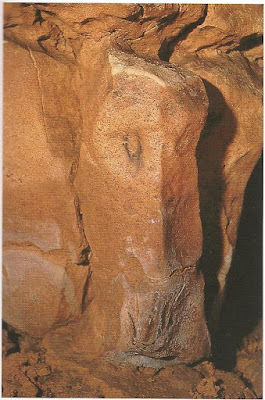
Here is a ‘mask’ from the deepest passage of Altamira Cave in Spain. It could be a horse, but it remains ambiguous. Lewis-Williams quotes anAmerican archeologist, Thor Conway, who visited a Californian rock art sitecalled Saliman Cave:
Red and black paintings surround two small holes bored intothe side of the walls by natural forces. As you stare at these entrance ways toanother realm, suddenly – and without voluntary control – the pictographs breakthe artificial visual reality that we assume.... Suddenly, the paintingsencompassing the recessed pockets began to pulse, beckoning us inward.
Painted Dreams, Native Americal Rock Art,T.Conway, p109-10
Lewis-Williams comments that certain South African rock paintings by the San, that 'seem tothread in and out of the the walls of rock shelters' may 'similarly came to life anddrew shamans through the ‘veil’ into the spirit realm.’ So is it possible that the notion of paintingsas portals may go back all the way to the Paleolithic? That’s quite a thought.
Picture credits:
The Snake-Charmer by Henri Rousseau, 1907, Musee D'Orsay, wikipedia
The Voyage of The Dawn Treader: illustration by Pauline Baynes
Marianne Dreams: illustration by Marjorie Ann Watts
Katie's Picture Show: illustration by James Mayhew
The Cornfield by John Constable, 1826, National Gallery
Photo from Altamira Cave: David Lewis-Williams, 'The Mind in the Cave'



